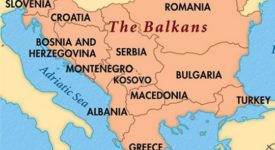Last Thursday in June, the German chancellor, Angela Merkel, warned that the future of the EU depended on whether it could find answers to the question of migration. The future of the European project depends not just on whether the EU can deal effectively with refugees in the Mediterranean, but also on whether it can find a way to reconcile diverging conceptions of what Europe should be.
It is above all the euro and refugee crises – which have become acute again almost simultaneously in the last couple of months – that have divided Europe along geographic and political lines. On each of the two issues, EU member states have formed different coalitions. For example, whereas Greece and Italy opposed Germany in the euro crisis, they now find themselves on the same side of the argument about migration – even as ‘populist’ parties have come to power in Greece and Italy.
Amidst this turmoil, three competing visions have emerged. The first is Merkel’s idea of a ‘competitive’ Europe. Under her ‘leadership’ since the euro crisis began in 2010, the EU has increasingly become a vehicle for imposing market discipline on member states. It is in the name of this idea of a competitive Europe, led by Germany, that austerity has been imposed on debtor countries in the Eurozone. In other words, although it is expressed in pro-European terms and involves further integration, it is essentially a neoliberal vision.
The second vision is the French president Emmanuel Macron’s idea of a ‘Europe that protects’. Macron envisages an EU in which there would be greater solidarity between citizens and between member states. In practice, this means more redistribution and risk-sharing in the Eurozone – the ‘transfer union’ that Germany and other creditor countries fear. This is a center-left vision of Europe – although in France, because Macron has implemented structural reforms in an attempt to gain credibility in Berlin, he is himself increasingly perceived as neoliberal.
The third vision is the Hungarian Prime Minister Viktor Orbán’s idea of a ‘Christian’ Europe of sovereign states. His vision first emerged in response to the attempt, led by Germany, to force EU member states to accept mandatory quotas of refugees in 2015, but it has developed into a broader critique of the European project. Orbán defines himself as an ‘illiberal democrat’ in opposition to what he sees as the undemocratic liberalism of the EU. His vision is shared not just by the Law and Justice party government in Poland but also by far-right parties in other EU member states.
Both centrists and populists see an elemental struggle between liberalism and illiberalism taking place. But the reality is messier – as illustrated by the fact that, despite their apparent differences on the issue of migration, Merkel’s ‘liberal’ Christian Democrats and Orbán’s ‘illiberal’ Fidesz party remain in the same grouping in the European parliament, the center-right European People’s Party. Somewhere in between is the Bavarian Christian Democrats (CSU), led by the German interior minister, Horst Seehofer, who has threatened to bring down the Merkel government unless she moves further towards Orbán’s vision.
Nevertheless, the differences between the three visions are real. The danger is that the contradictions between the three visions will make the EU increasingly dysfunctional – exacerbating the backlash against it. Some two weeks ago, the new Italian government – a coalition of the anti-establishment Five Star Movement and the far-right League – was so frustrated by the failure to make progress on migration that it refused to sign the conclusions of the European Council.
Italy – which is now at the center of both the euro and refugee crises as much as Greece once was – could be the key swing state in the three-way clash of visions. There are sections of Italian society that support each, but each vision is a response to the rise of Euroscepticism in a different part of the continent and an attempt to reconnect the EU to citizens. The problem is that the visions are incompatible. What it would take to reduce Euroscepticism in Southern Europe would increase it in Northern Europe – and vice versa. Similarly, what it would take to reduce Euroscepticism in Eastern Europe would increase it in Western Europe – and vice versa. The question is whether there is a way out of this zero-sum game.
‘Competing Visions of Europe Are Threatening to Tear the Union Apart’ – Commentary by Hand Kundnani – Chatham House / The Royal Institute of International Affairs.







